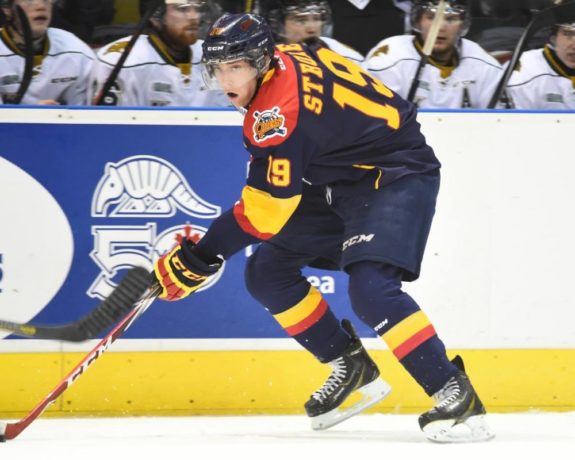
Picture this: a young 17-year old centre, possessing the perfect frame to withstand the physical NHL game at 6’3″, 187 pounds, has just finished up a banner season in which he tallied 129 points in just 68 games to lead the Ontario Hockey League in scoring. Sounds like a player who should be gunning for a top draft selection in the upcoming draft, right? Dylan Strome has raised his stock tremendously throughout the year, beginning the season as a borderline top-10 pick and finishing it as a top option behind the powerhouse duo of Connor McDavid and Jack Eichel. With the draft rapidly approaching, here is a quick analysis of the current Erie Otter.
Playing Style
Reading through scouting reports of Dylan Strome, a common concern is his lack of top-end speed. As Christopher Ralph noted in a recent scouting report, Strome’s skating has been criticized in the past and he is “…working very hard to improve his acceleration and top-end speed” in preparation for the NHL draft. However, he has also been lauded for his vision, playmaking skill, and defensive skill which make him a great two-way player. Recently, many players with Strome’s lethal combination of size, skill, and playmaking skill have developed into elite NHL centres despite a perceived lack of top-end speed. Take this scouting report on current Los Angeles Kings star Anze Kopitar from before his draft year, written by Elite Prospects:
|
Eerily similar to Strome’s, right? Despite his perceived weakness in skating speed, Strome has proven time and time again throughout his junior career that his vision and hockey sense more than make up for this deficiency, and there’s no reason to think that a big centre like Dylan Strome won’t have a successful NHL career. Despite lacking high-end skating speed off the rush, there are few more dangerous players in the draft below the faceoff circles. Strome has the uncanny ability to control the pace of the game with the puck on his stick, and he is strong enough on his skates to protect the puck well and hold on to it long enough to find an open teammate. Several NHL stars have had successful careers despite lacking top-end speed, such as Joe Thornton of the San Jose Sharks or Nicklas Backstrom of the Washington Capitals. However, due to his playmaking skill, his complete two-way game, puck protection ability, and proficiency in shooting the puck, I think Dylan Strome’s game is quite similar to that of Anze Kopitar of the Los Angeles Kings.

Potential Fits
Due to the elite talent available in Connor McDavid and Jack Eichel, it is most likely that Dylan Strome gets chosen in the 3rd to 6th range in the upcoming draft. Let’s take a minute to explore how Strome would fit in on the clubs holding these selections and who would be most likely to select him.
Arizona Coyotes
The Arizona Coyotes were dealt a bad bounce when Edmonton was announced as the winner of the draft lottery; it bumped them down from the 2nd overall selection and a chance at a generational talent (Eichel) to their pick of the rest of a very strong crop of prospects. Despite disappointment at missing out on Eichel or McDavid, getting a player like Strome would be a coup for a team as starved for offensive talent as the Coyotes. As listed on Hockey’s Future, aside from Max Domi (who might be better suited on the wing in his transition to the NHL), there is not one centre prospect in their system who has a great chance at becoming a true first line centre. Competing in the rough-and-tumble Western Conference against teams such as Anaheim and Los Angeles (and their star, Anze Kopitar), getting a big, strong number one centre is almost a necessity. Not only could Strome potentially fill that role in spades, his familiarity with current Coyotes prospects and OHL grads Domi and Christian Dvorak could end up forming one potent line.
Toronto Maple Leafs
I don’t know if you could imagine a more storybook headline – a local hockey star, born and raised a Maple Leafs fan, gets drafted by his hometown team, who happen to be starved for an elite centre. Toronto has improved its lackluster draft reputation in recent years, which has given their prospect pool a bit of a surplus when it comes to skilled but small forwards. Not only would adding a big, young talented centre like Strome possibly solve their need for a first line centre, adding Strome to a young forward group that already includes the likes of Nazem Kadri, William Nylander, and AHL All-Rookie team member Connor Brown could make the Leafs an offensive force in years to come.
New Jersey Devils
It’s no secret that in recent years, the Devils have lacked enough offensive firepower to compete for a playoff spot. In addition to that, there doesn’t seem to be much help on the way, as New Jersey fielded the oldest team in the NHL last season, and their prospect group was recently ranked a measly 27th in the NHL by Hockey’s Future. Having Strome fall into their laps at 6th would be something of a small miracle, but if it happens, then the Devils would be wise to snap him up in an instant. New Jersey’s prospect pool currently doesn’t contain a forward projected to be a first line player, but adding Strome would change that. Playing in a division filled with star centres such as Sidney Crosby, Claude Giroux, and John Tavares, New Jersey must add a player who could eventually develop into an elite centre. Adding a stud prospect with the vision, shot, and two-way prowess that Strome possess would certainly help.

Behind the consensus top two choices in McDavid and Eichel, there are three players jockeying for positioning: London’s Mitch Marner, Boston College’s Noah Hanifin, and Strome. While some may argue that Marner may possess a higher skill level than Strome, or adding an impact defender like Hanifin is more important than a first-line centre, I believe that Strome is the third best prospect available for the draft this year.
In the last five seasons, the Stanley Cup has been won by only three franchises: The Chicago Blackhawks, Boston Bruins, and Los Angeles Kings. Each of these teams has a similar, but critical component – they all have a sizeable, two-way centre who can score in bunches, but also takes care of business in his own end. While Jonathan Toews, Anze Kopitar, or Patrice Bergeron may not light up the scoresheet like offensive stars Sidney Crosby or Claude Giroux, their impact on the game in all three zones provides these elite franchises with a centrepiece with which to build their teams around. While it would be a stretch to assume Strome will develop into a perennial all-star like these players, he certainly has the potential to turn into a special player.
In today’s low-scoring NHL, it is becoming increasingly important for teams to have their best players in the offensive zone also be their best players in the defensive zone and in the physical aspect of games. While Marner may be considered the superior offensive player to Strome, his small stature could potentially pose problems when transitioning to the NHL in the future. Strome has the ideal frame to put on weight and succeed when playing against some of the biggest centres in the NHL, such as Kopitar, Ryan Getzlaf, or Evgeni Malkin. In addition, Strome is no slouch in the offensive zone, either. He possesses elite vision, which allows him to find open teammates at opportune times. He succeeds in any game type, whether the game is wide-open and fast-paced, or slow and tight-checked. While he is a playmaker first and foremost, he also has a lethal shot which he is not afraid to let fly from anywhere in the offensive zone. Put all these aspects together, and one lucky team in June may have a star on their hands.